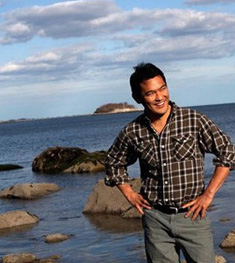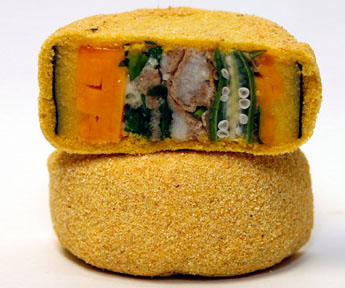
On a recent evening in New Haven, Connecticut, chef Bun Lai held court in a busy corner of his restaurant, Miya’s Sushi. Sitting at a table crowded with dishes, he traded fish jokes and talked seafood, expounding on the virtues of rock seaweed and Appalachian moonshine. The latest course had just been plunked down on the table with an unceremonious thud, and he was watching in amusement as his guests examined the food with varying degrees of bewilderment.
It’s a situation familiar to Lai, whose menu contains little trace of a typical sushi establishment. The dish in question was the delicious and unorthodox Peanut Butter and Jelly roll, an inventive combination of jellyfish, peanut butter, cucumber and rabbit that’s almost guaranteed to stump first-time diners. Jellyfish? Peanut butter? Rabbit?For those expecting California rolls, it’s a rude, if wonderful, awakening.
“The rabbit’s from Connecticut, actually,” he said. “From a farm that got some award for humanitarian efforts.” He grinned. “I should know this stuff.”
Rabbit, as it turns out, is quite the eco-friendly choice, providing more meat than a cow for a given amount of feed. They breed rapidly, take up little space, and produce meat that’s lean and healthy. As for the jellyfish, both overfishing and the acidification of oceans have eliminated many of the invertebrate’s natural predators, resulting in the explosive growth of world jellyfish populations.
So why not add them to the menu, says Bun Lai – saving the seas, one delicious piece of sushi at a time.
And this is all in one roll. The concepts at work in the Peanut Butter and Jelly roll characterize every dish that passes from Lai’s kitchen, which maintains a playful and fantastically innovative commitment to sustainability. The concept of “sustainable sushi” is something of an oxymoron to most of the world, but not in this little corner of New Haven. In fact, it’s a genre that Lai practically invented, tossing out the heavily leaned-upon sushi ingredients in favor of the local, the safe, the clean, the unpopular. Miya’s offers no freshwater eel, yellowtail, octopus, farmed salmon, or Maine sea urchin. And the restaurant is busy expanding that list to include other ingredients that are particularly harmful to the environment.
“We got rid of shrimp,” he said, “and we’re phasing out tuna.” Shrimp is imported with minimal inspection. The small fraction of shrimp that do receive inspection are regularly contaminated with herbicides and pesticides, which bodes ill for the local sushi joint. Tuna, on the other hand, is the lifeblood of the sushi industry. While Lai can get sustainable tuna, he prefers to veer from the mainstream whenever possible.
“The whole foundation of sushi is tuna,” he said. “If I’m going to turn sushi on its head, I’ve got to get rid of tuna.”
Instead, he uses sea robin. Arctic char. Dogfish, bluefish, catfish. Horse radish grown by the Yale Farm. Tilapia from the Bridgeport Aquaculture School. Asian shore crabs. The list goes on. If he’s not sourcing local, then he’s drawing on invasive species, and if not that, then the food has some other interesting story behind it. The Miya’s menu – Wonka-esque, a kaleidoscope of foods – is sixty pages long, and when Lai can’t find the right fish, he ignores it altogether: three-quarters of the menu is vegetarian, which is cheaper, healthier, and more environmentally friendly than seafood.
“It’s always an experiment,” he said.
Lai also owns 100 acres of oyster fields in the Long Island Sound, where he dives regularly. While his oysters haven’t yet made it to the menu, it’s only a matter of time before the commercial license comes through. For now, he takes day-long jaunts to dive for the appetizing creature with oysterman Bren Smith of Thimble Island Oyster Company. The two even started a Community Supported Fishery, which is a seafood-oriented take on Community Supported Agriculture. They offer subscribers the opportunity to receive oysters, clams, and other fish fresh from the Sound on a regular basis,
Clearly, Lai’s no typical chef, content to hang up the hat at night’s end. Seafood has become far more than a way to make a living. Lai literally grew up at Miya’s, which his mother founded in the early eighties. Since taking the helm, he has plunged into the business with the combined creative energy of a fish enthusiast and an environmental activist. “My rule of thumb is if I think I can do something better than what’s traditional, I’ll make the change,” he said.
Miya’s is, more than anything, defined by its remarkable thoughtfulness. Lai spends many of his nights surrounded by drinks and delectables, teasing out the broader implications of eating sushi. His cuisine is as philosophical as it is delicious; his menu cites Buddhist principles, the Hebrew Bible, and “traditional Japanese aesthetics,” offering gems like “Eat it slowly as a meditation on impermanence.”
The way we eat says a lot about our relationship with the environment. What we take from the earth, how we take it, what we do with it: all of these questions have found purchase at Miya’s. For environmentally conscious eaters, there is no better alternative to the fish industry than a Miya’s roll of sushi. Grab some sake while you’re at it, and keep the conversations flowing.

Featured photo by Stephen Brooks.